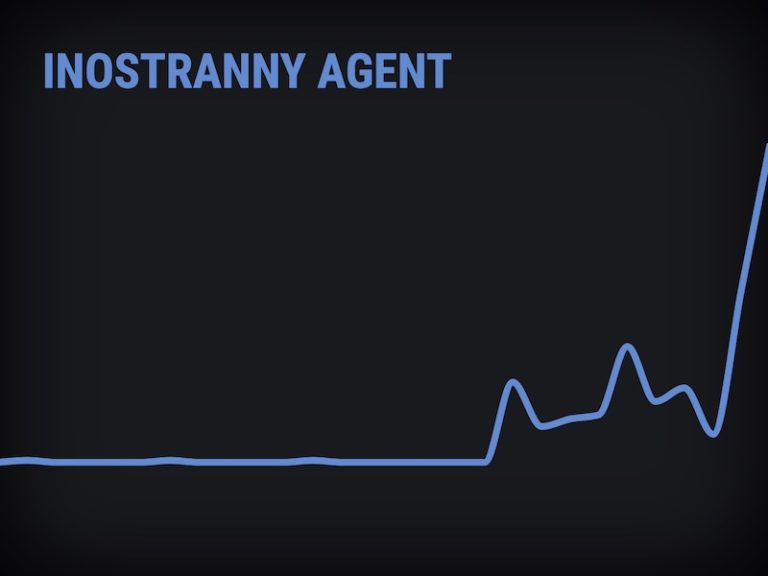A cat meme goes viral on the Russian-language Internet. On Facebook, university lecturer Irina Znamenskaya asked – how can the language-based joke be translated? Sasha Kharitonski responded in a post which Zachary King translated into English. Alexandra Berlina’s addendum seeks to answer the question: What are memes, actually?
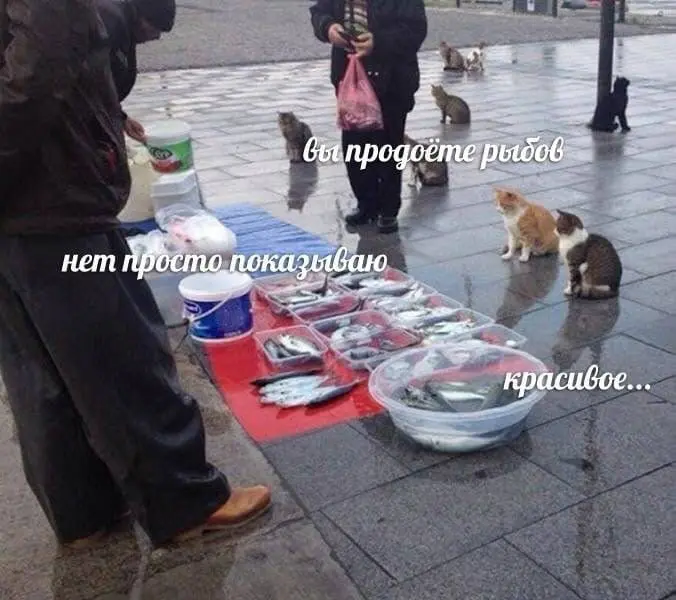
“do you sell fishes?”
“no i’m just showing them”
“butiful…”
Irina, your request to explain the fish meme to a foreigner wouldn’t let me go. So I made a serious effort. Or I had some fun, depending on how you look at it.
It all starts with the NOT-fishmonger. In reality, the question “do you sell fishes?” would be completely inappropriate, because it’s obvious he’s selling them. In Russia it would be completely normal for someone to simply lay out their goods on the asphalt, if they didn’t have a table. There is no other way to interpret the fish being laid out on a tablecloth on the street.
Yet the answer, “no, I’m just showing them” would be possible. It would be an ironic response to the obvious: yes, I sell fish, what’s with the stupid question? Most Russians don’t like wasting words and stupid questions.
The absurdity of the situation lies in the fact that, based on the context of the conversation, he really is just showing them. He came out to show the fish to passers-by. It is pointless and absurd.
Or: The answer really was meant sarcastically, but the kittens take it at face value, as the ultimate truth, the uncompromising reality. The fish are on display. They cannot be bought. They cannot be eaten. From here, the dramatic tension arises and grows.
The kittens give a distinctly endearing response with their “butiful”. They are sitting by them, these beautiful and surely tasty fish, looking at them, probably drooling over them, but they can’t have them. And they pretend it’s fine, as if they were just passing by and can appreciate the beauty on display. And they are very polite. Like children without any pocket money.
Without going into too much detail, this feeling is extremely familiar to Russian people. It is part of the cultural code.
And all this opens up another layer of understanding: Even if the fish were for sale, the kittens still have no money.
The emotion and absurdity increases with this unattainability of their desire. The fish are right there, yet they are far beyond reach. The depth of the joke is in the bitter note that, as I said, is familiar to most Russian people. Dostoevsky, Tolstoy, Kuprin – this meme is made very much in the context of great Russian culture.
The answer “butiful” vaguely suggests what a person at an art gallery might say, but is combined here with a totally inappropriate object of aesthetic contemplation: fish. The fish have almost become an art object exhibited by the NOT-fishmonger – yet they remain fish on the street.
The use of language in this small but striking example of memology adds to its brilliance: The incorrect use of the grammatical case in “fishes” (rybov) provides the kittens individuality and cuteness – making the meme even more memorable and recognisable.
The inappropriate word “butiful” – in Russian in neuter form, which doesn’t agree with any noun in the meme – helps recall the cultural art context and completes the sense of absurdity.
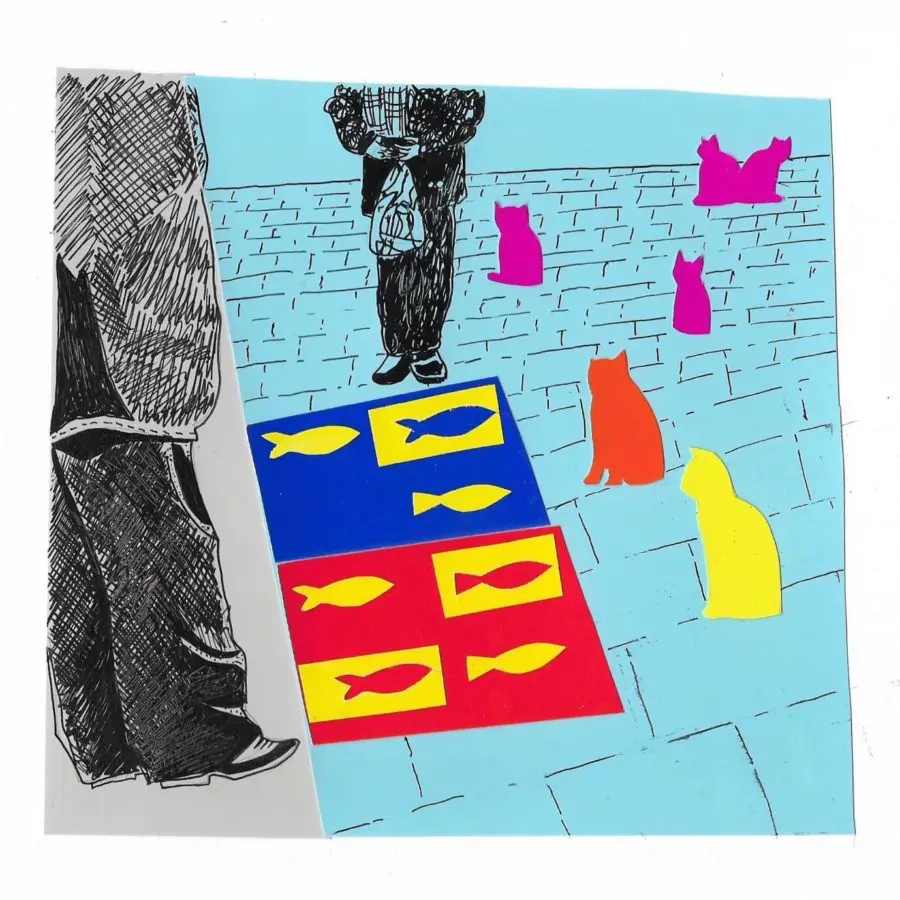
Addendum by Alexandra Berlina: What are memes, actually?
These days, a German-speaker could call almost any image with a funny caption a Meme. Duden, the standard German-language dictionary, defines a Meme as an “(interesting or amusing) image, video or similar item that is spread rapidly and widely in social networks”. In English, the word is used in much the same way.
In Russian, however, the word мем tends to be used in a narrower sense, one closer to the original meaning: Richard Dawkins developed the word meme as a parallel to gene to refer to a cultural unit that undergoes mutation. Thus, while the Russian word мем also refers mainly to amusing images, it is primarily used for images whose humour is generated through variation and repetition. The first time one sees the original fishmonger and the cats meme discussed above, for instance, it calls for a low-key response, no more than a benign smile. But as the meme appears in different contexts and in different variations, the effect grows – until, at some point, the meme is exhausted and stops having an effect. A variation might show the same text associated with a different image, e.g.:
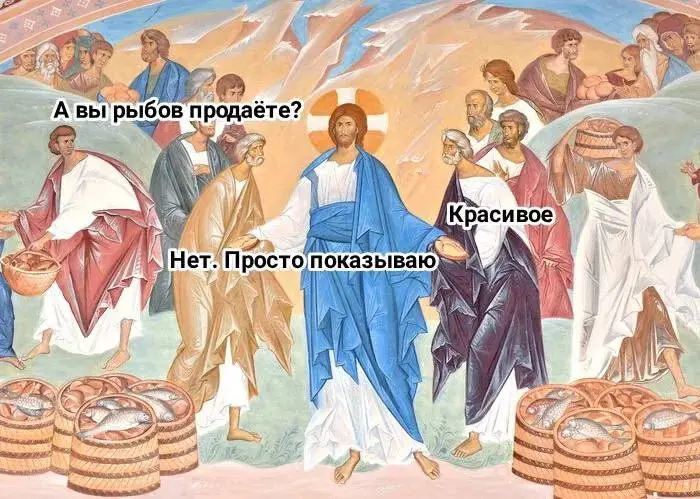
As this illustrates, a reaction of this kind can be quite controversial – fortunately, one seldom knows who the creator of a meme is, which makes it difficult to lay the charge against them of insulting the feelings of religious believers.
Another variation might use the same image but provide a different text. Going meta is definitely an option for these – as this meme about memes illustrates:
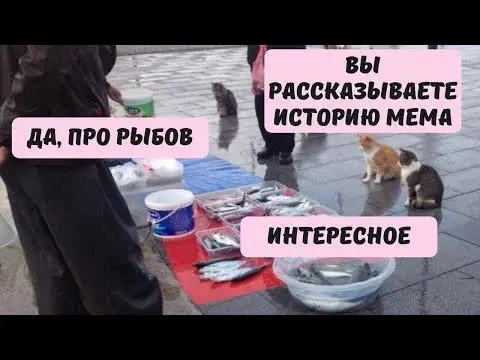
(Cat:) You are speaking of the history of the meme?
(Man:) Yes, about fishes
(Cat:) Interesting, this






